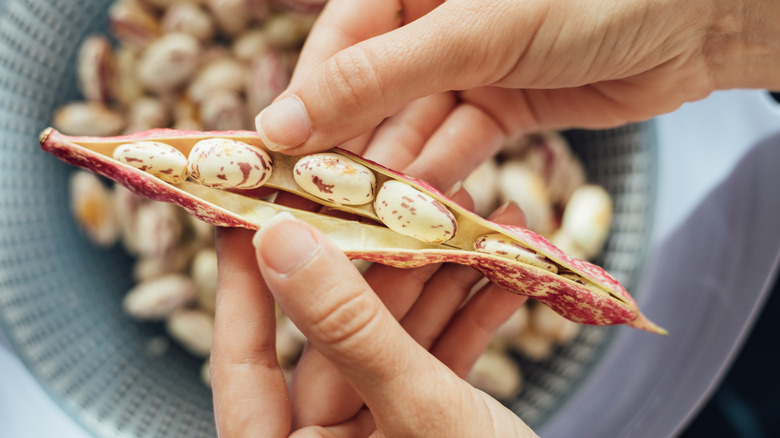Eating Cranberry Beans Every Day Has An Unexpected Effect On Your Blood Pressure
When you hear about cranberries, you probably think of the tart crimson fruit associated with the holidays. However, there's another type of cranberry that you might want to bring into your diet, especially if you're interested in lowering your blood pressure: cranberry beans.
You might have already seen cranberry beans at your local market and not realized what they were. They have an off-white color and telltale reddish flecks, splotches, and streaks, and are sometimes referred to as borlotti beans. Consequently, you may have already used or eaten cranberry beans without realizing it, especially if you're fond of Italian bean dishes (where borlotti beans are often found).
Like all beans, cranberry beans are protein-rich. Per the U.S. Department of Agriculture (USDA), a 100-gram serving of uncooked cranberry beans contains a healthy 24 grams of protein. Yet cranberry beans' protein content isn't what makes this bean potentially beneficial for individuals battling hypertension. Four other nutrients give cranberry beans their blood pressure-friendly reputation. And to learn more about those nutrients, Health Digest talked to Angel Luk, a registered dietitian.
Heart-friendly nutrients in a versatile bean
According to Luk, the substantial amount of fiber, potassium, magnesium, and calcium in cranberry beans make them possibly valuable for people interested in lowering their blood pressure. As she explains, "Foods that are rich in fiber, potassium, magnesium, and calcium are part of the DASH (Dietary Approaches to Stop Hypertension) diet [and] there is robust research indicating these foods lower blood pressure when enjoyed as part of an eating approach that is also lower in added salt, sugar, and saturated fat." The DASH diet is commonly prescribed for people who are trying to control their blood pressure levels, and focuses on eating fat-free foods like beans (via the National Heart, Lung, and Blood Institute).
In a 2024 review in Hypertension, researchers examined studies on the relationship between fiber and blood pressure. They concluded that for every 5 grams of fiber eaten above the recommended daily amount, an individual could expect to see a slight reduction in both systolic and diastolic blood pressure readings. That amount of fiber isn't hard to get with cranberry beans: Data from the USDA shows that 100 grams of dried cranberry beans offer 4.3 grams of fiber, so consuming them daily could work toward keeping your blood pressure down.
Brimming with potassium and magnesium
Where does potassium fit into the mix? The potassium in 100 grams of cranberry beans is 1,340 milligrams, or about one-quarter to one-third of the average daily recommended potassium for an adult. The American Heart Association explains that potassium helps remove excess sodium from the body and can relax the blood vessels; thus, eating cranberry beans every day could have blood pressure-decreasing effects.
Moving on to magnesium: In 2022, the Federal Drug Administration (FDA) made a public announcement accepting claims that magnesium could bring down blood pressure, provided that they are "appropriately worded." The agency noted that "the totality of the scientific evidence supports a qualified health claim on the relationship between magnesium and a reduced risk of high blood pressure in conventional foods and dietary supplements." With that said, the FDA did not specifically advise taking magnesium for the purpose of reducing one's high blood pressure risk, stating that the available scientific evidence is still currently "inconsistent and not conclusive."
Chock full of calcium and adaptable to recipes
Calcium is the fourth heart-healthy cranberry bean nutrient. In a 2019 review in Nutrients, researchers analyzed past experiments on the correlation between calcium and lowered blood pressure. They concluded that when calcium intake rose, blood pressure levels declined. Therefore, consuming cranberry beans along with other calcium-packed foods could have a positive outcome on blood pressure readings.
If you're not accustomed to eating beans (or at least eating cranberry beans) every day, Luk has a few suggestions. She says they can be tossed into any bean-based recipe. "They can also easily be sprinkled into any garden salads, mashed into dips such as guacamole, or seasoned with a light drizzle of olive oil and herbs for an elegantly simple warm bean salad."
Just remember that cranberry beans have a distinct flavor — sometimes described as subtly nutty and a bit sweet — that might change the overall tone of your favorite bean meals. Therefore, you may want to adjust other seasonings to either bring out or dampen the earthiness of this versatile food.



